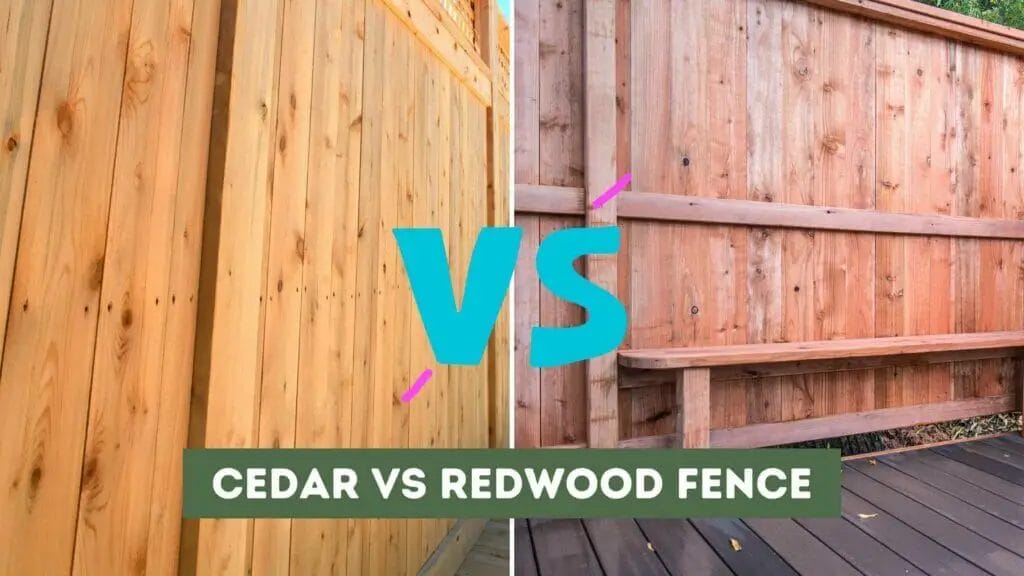
If you’re planning on installing a fence around your property, you may be wondering which wood is better: cedar or redwood. Both kinds of wood are known for their strength, durability, and natural resistance to pests and rot, but they also have their unique characteristics that set them apart.
Cedar and redwood are both popular choices for fencing thanks to their natural beauty and ability to enhance the curb appeal of your property. Cedar is known for its warm, reddish-brown color that can be stained to match any home’s exterior. Redwood, on the other hand, has a natural reddish hue that adds a touch of elegance to any property.
In terms of strength, redwood is generally considered to be sturdier than cedar, but cedar is lighter and easier to work with. Below, we’ll dive deeper into the differences between cedar vs redwood fence and help you make an informed decision.
Key takeaways:
- Cedar and redwood are popular choices for fencing due to their natural beauty and curb appeal.
- Cedar has a warm, reddish-brown color that can be stained to match any home’s exterior, while redwood has a natural reddish hue that adds elegance.
- Redwood is generally considered sturdier than cedar, but cedar is lighter and easier to work with.
- Cedar wood is known for its natural oils, making it resistant to rot, decay, and insects. It has a straight, tight grain with few knots and is lightweight.
- Redwood has a rich, reddish-brown color and contains tannin, a natural preservative that protects it from decay and insects. It is strong, durable, and resistant to warping and shrinking.
- Redwood is slightly more rot-resistant than cedar and has a higher Janka hardness rating, making it stronger.
- Cedar is a more budget-friendly option, but it requires more maintenance than redwood, which is more durable and longer-lasting.
Understanding Cedar and Redwood
When it comes to choosing between cedar and redwood for your fence, it’s important to understand the unique features of each wood. Both woods are popular choices for fencing due to their natural beauty and durability. In this section, we will explore the characteristics of cedar and redwood to help you make an informed decision.
Cedar Features
Cedar wood is known for its natural oils, which give it a distinctive aroma and make it resistant to rot and decay. These oils also make cedar wood resistant to insects, making it a popular choice for outdoor projects. Cedar wood has a straight, tight grain with few knots, which makes it easy to work with and gives it a uniform appearance. Cedar wood is also lightweight, which makes it easier to handle and install than other types of wood.
Redwood Features
Redwood is a natural product that is known for its rich, reddish-brown color and durability. It contains tannin, a natural preservative that protects the wood from decay and insects. Redwood has a straight, tight grain with few knots, which gives it a uniform appearance. It is a dense wood that is strong and durable, making it a good choice for outdoor projects. Redwood is also resistant to warping and shrinking, which makes it a good choice for fencing.
When comparing cedar and redwood, it’s important to consider the specific characteristics of each wood. Cedar is a good choice for those who want a lightweight, easy-to-handle wood that is resistant to insects and decay. Redwood is a good choice for those who want a strong, durable wood that is resistant to warping and shrinking.
Appearance and Aesthetics
When it comes to choosing between Cedar and Redwood for your fence, the appearance and aesthetics of the wood are a crucial factor to consider. Both Cedar and Redwood offer a natural beauty that can enhance the curb appeal of your property.
Cedar has a yellow undertone, which gives it a warm and inviting look. It has a smooth texture and a natural color that ranges from light brown to red. Cedar can also be tinted with a stain to achieve a particular color. On the other hand, Redwood has a reddish-brown hue that gives it a rich and luxurious appearance. It has a smooth surface that is free of knots and has a natural color that ranges from light pink to deep reddish-brown.
The natural color of Cedar and Redwood will change over time due to exposure to sunlight and weather conditions. Cedar will turn grayish-silver over time, while Redwood will turn a deep reddish hue. However, both woods can be stained to maintain their natural color and prevent the effects of weathering.
When it comes to aesthetics, both Cedar and Redwood offer a classic and timeless look that can complement any architectural style. Cedar is often used for a rustic or cottage-style fence, while Redwood is often used for a more modern or contemporary fence.
In terms of smoothness, Cedar has a slightly rougher texture compared to Redwood, which has a smoother surface. However, Cedar can be sanded to achieve a smoother finish.
Durability and Strength
When it comes to choosing between cedar and redwood for your fence, durability and strength are two important factors to consider. Both woods are known for their natural resistance to rot and decay, making them popular choices for outdoor use. However, there are some differences between the two when it comes to their overall strength and longevity.
One way to measure the strength of wood is through the Janka hardness test, which measures a wood’s resistance to denting and wear. Redwood has a higher Janka rating than cedar, with a rating of 450 pounds compared to cedar’s 350 pounds. This means that redwood is measurably stronger than cedar by about 23%.
In terms of resistance to rot and decay, both cedar and redwood are excellent choices. However, redwood is considered to be slightly more rot-resistant than cedar. This is due in part to the fact that redwood contains more tannins, which help to repel insects and fungi that can cause decay.
When it comes to longevity, both cedar and redwood can last for many years with proper care and maintenance. However, redwood is generally considered to be more durable and longer-lasting than cedar. This is due in part to its higher strength and rot-resistance, as well as its natural ability to withstand weathering and exposure to the elements.
To ensure that your cedar or redwood fence lasts as long as possible, it’s important to take proper care of it. This includes regular cleaning and maintenance, as well as applying a protective finish to help prevent damage from moisture, sunlight, and other environmental factors. With the right care and maintenance, your cedar or redwood fence can provide many years of beauty and protection for your home and property.
Resistance to Rot and Insects
When it comes to choosing between cedar and redwood for your fence, one of the most important factors to consider is their resistance to rot and insects. Both cedar and redwood are known for their natural resistance to rot and insects, making them great options for outdoor use.
Cedarwood, in particular, contains natural oils that make it resistant to moisture and pests such as termites. This makes cedar fences last for a very long time, even in harsh weather conditions. Redwood, on the other hand, is naturally highly resistant to rot and insects due to its naturally acidic wood and high levels of tannin.
Tannin is a natural chemical that gives redwood its distinct color and also acts as a natural preservative. This makes redwood a great option for outdoor use, as it can withstand exposure to the elements without deteriorating.
Overall, both cedar and redwood are great options for fences due to their natural resistance to rot and insects. However, it’s important to note that no wood is completely immune to rot and insects, so proper maintenance and care are still necessary to ensure the longevity of your fence. Regular cleaning, staining, and sealing can help protect your fence from the elements and keep it looking great for years to come.
Cost Analysis
When it comes to choosing between cedar and redwood for your fence, cost is an important factor to consider. The price of both types of wood can vary depending on several factors, including the quality of the wood, the region you live in, and the size of your fence project.
On average, the cost to install a cedar or redwood fence on your property is between $15 to $35 per square foot. Labor costs can also vary, with an average of $20-$50 per hour depending on the property size and the scope of work. Keep in mind that these costs can significantly increase for a redwood fence. For example, a 200-linear foot redwood fence can cost around $6,270.
If you’re on a tight budget, cedar may be the more affordable choice. However, it’s important to note that cedar requires more maintenance than redwood. This can include regular staining or sealing to prevent rot and decay, which can add to the overall cost of your fence project.
When it comes to value, redwood may be the better option in the long run. Redwood is more durable than cedar, and its natural oils make it resistant to rot and decay. This means that redwood fences can last longer and require less maintenance over time, which can save you money in the long run.
If you’re looking for a cost comparison between cedar and redwood, here’s a breakdown of the average cost per linear foot:
| Wood Type | Average Cost per Linear Foot |
|---|---|
| Cedar | $10-$15 |
| Redwood | $12-$20 |
Keep in mind that these prices can vary depending on your location and the quality of the wood you choose.
Maintenance and Sustainability
When it comes to maintaining your fence, cedar, and redwood have different requirements. Cedar is less durable than redwood and is more prone to rot and insect damage. To keep your cedar fence looking good, you’ll need to stain or paint it every two to three years. Redwood, on the other hand, is more resistant to rot and insects, so it requires less maintenance. However, it is still a good idea to stain or paint your redwood fence every three to five years to protect it from the elements.
Both cedar and redwood are sustainable options for fencing. Cedar is a fast-growing tree that is harvested from managed forests, making it an eco-friendly choice. Redwood is also harvested from managed forests and is certified by the Forest Stewardship Council (FSC) for its sustainable practices. Both types of wood are also biodegradable, meaning that they won’t harm the environment when they eventually break down.
If you’re looking for an eco-friendly option, consider using a natural stain or paint on your fence. These products are made from plant-based materials and are safer for the environment than traditional chemical-based products. You can also choose to leave your fence unstained or unpainted, which will allow it to weather naturally over time.
Pro Tip: To keep your fence looking good for years to come, make sure to trim any vegetation that grows around it. Plants can trap moisture against the fence, which can lead to rot and other damage.
Availability and Installation
When it comes to availability and installation, both cedar and redwood are popular choices for fencing. Cedar is widely available in most regions of the United States, while redwood is more commonly found in the western part of the country. However, both woods can be sourced from specialty lumberyards and suppliers.
The installation process for cedar and redwood fences is similar, with both requiring the same basic steps. However, due to its softer nature, cedar is generally easier to work with and can be installed more quickly. Redwood, on the other hand, is denser and may require more time and effort to install.
When it comes to curb appeal, both cedar and redwood fences are highly desirable. Cedar has a warm, reddish-brown color that can be left to weather naturally or stained to maintain its color. Redwood has a distinct reddish-brown hue that can also be left to weather or stained to maintain its color.
One thing to keep in mind when installing a cedar or redwood fence is that it will require regular maintenance to keep it looking its best. This includes cleaning, staining, and sealing the wood to protect it from the elements.
Pros and Cons of Cedar and Redwood Fences
When it comes to choosing between a cedar and redwood fence, it’s important to weigh the pros and cons of each option. Both woods have unique characteristics that make them great choices for your backyard, but they also have some drawbacks to consider.
Cedar Fences Pros and Cons
Pros
- Cedar is a budget-friendly option compared to other types of wood fences.
- Cedar has a natural resistance to rot and decay, making it a durable option for your backyard.
- Cedar has a beautiful natural color that can enhance the look of your property.
- Cedar is a lightweight wood, making it easier to install and work with.
Cons
- Cedar is not as strong as other types of wood, which means it may not be the best choice for areas with strong winds or heavy snow loads.
- Cedar can be more susceptible to insect damage than other types of wood.
- Cedar may require more maintenance than other types of wood, including regular staining or sealing to maintain its color and protect it from the elements.
Redwood Fences Pros and Cons
Pros
- Redwood is a beautiful wood with a rich, natural color that can enhance the look of your property.
- Redwood has a natural resistance to rot and decay, making it a durable option for your backyard.
- Redwood is a strong and sturdy wood that can withstand strong winds and heavy snow loads.
Cons
- Redwood is a scarce resource, which can make it more expensive than other types of wood.
- Redwood may not be as budget-friendly as other types of wood, making it a less attractive option for some homeowners.
- Redwood may require more maintenance than other types of wood, including regular staining or sealing to maintain its color and protect it from the elements.
FAQ: Cedar vs Redwood Fence
What are the differences between cedar and redwood for outdoor use?
Cedar and redwood are two of the most popular types of wood used for outdoor projects. Both woods have a natural resistance to rot, decay, and insects. However, there are some differences between the two. Cedar is a softer wood than redwood, which makes it easier to work with and less likely to split. Redwood, on the other hand, has a distinct red-brown color, while cedar can be red, yellow, or white.
Which type of wood is more durable for a fence, cedar or redwood?
Redwood is generally considered to be more durable than cedar. It has a higher density and is more resistant to rot and decay. However, cedar is still a good choice for a fence, especially if it is properly maintained.
How long can a redwood fence last compared to a cedar fence?
A well-maintained redwood fence can last up to 25 years or more, while a cedar fence can last up to 20 years. However, the lifespan of a fence depends on many factors, including the quality of the wood, the climate, and how well it is maintained.
What are the advantages of using cedar for a fence?
Cedar is a popular choice for a fence because it is affordable, lightweight, and easy to work with. It also has a natural resistance to rot, decay, and insects. Cedar has a beautiful natural color that can be stained or painted to match your home’s exterior.
What are the advantages of using redwood for a fence?
Redwood is a premium wood that is known for its durability and natural beauty. It has a distinct red-brown color that can add warmth and character to your home’s exterior. Redwood has a higher density than cedar, which makes it more resistant to rot and decay.
Which type of wood is better for raised beds, cedar or redwood?
Both cedar and redwood are good choices for raised beds. They are both naturally rot-resistant and can last for many years. Cedar is a more affordable option, while redwood is more expensive but has a higher density and is more resistant to decay. Ultimately, the choice between cedar and redwood will depend on your budget and personal preferences.












